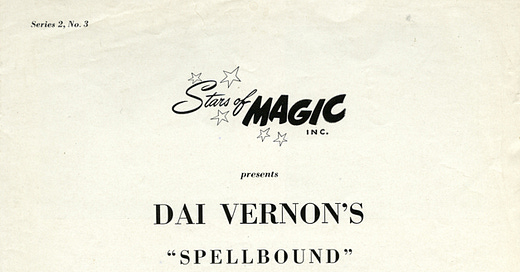I’ve been AWOL due to an epic trip to India, and my first interactions with the magic scene in Bangalore. I’ll share more about that in next week’s issue, but right now, I want to catch up on some unfinished business.
A few weeks ago, I mentioned the booklets that were provided to The Retreat attendees. Of course, that set my mind off in new directions, and I started looking at some of my favorite small booklets. In this issue, I’ll share what I’ve been learning from less involved magic publications, and at the end, I’ll share my take on Extra Sensory Perception, as mentioned in this Erudite Magic episode.
Why booklets?
I know most of us prefer meaty books with plenty of tricks, but sometimes an author or creator has something important to say, but it won’t take up a huge amount of pages. Size has little to nothing to do with the quality of the material. In fact, there’s a lot of historical magic material that was published as a booklet that led to amazing things.
For example, the Stars of Magic was originally released serially as individual trick write-ups. And yet, it provided us with classics like Triumph, Spellbound, the Ambitious Card, Paper Balls Over the Head, The Travelers, Card Stab, and more! Can you imagine life without these plots?! I am super grateful that the creators of these effects saw fit to publish them as a small piece, because if they had to go in a larger work, it’s quite possible that we may never have seen them.
One could equate the older trend of publishing booklets with the more modern idea of putting out a PDF or a self-published book. It’s a relatively low-cost way of putting something out there, even when you aren’t yet a proven commodity. What do you think? Do you purchase PDFs from independent creators?
Hidden gems
One of the real thrills I find is in mining a trick that very few other people are performing, and one of the easiest ways to make sure of that is to look in a source that many other people are not talking about. Booklets are a perfect source for this since full-size books get so much more attention in the commercial landscape.
I have plenty of both concepts and tricks I’ve taken away from booklets. For example, in Diverse Deceptions, Richard Osterlind teaches his version of Fourth Dimensional Telepathy. While I don’t use his version directly, he had a subtlety for numbering the envelopes that I did adopt, and it really made a difference in how fooling my version is.
Or, if you’re less of a mentalist, I really appreciated Nick Diffatte’s “Nest of Office Supplies,” originally found in his booklet Funny. The trick eventually made its way into his book Offbeat, so even if you didn’t get the original, you can still see how gems can be found in the most unlikely places.
What about you? What are some of your favorite “hidden gems” found in booklets? Comment below!
My favorite
As a mentalist, The Perfected Center Tear by Richard Osterlind is one of my favorite booklets. Of course, I’ve routinely touted the benefits of learning a center tear like the main subject, but the booklet offers so much more than just the core technique.
In spite of saying “I’m a mentalist,” I’m actually a big fan of blurring the lines between magic and mentalism. This booklet (and Richard Osterlind generally) does just that. In addition to learning the main point - the center tear - Richard goes on to teach the reader more than 10 other tricks, including:
A card trick that makes your participant forget their own name
One of the best switches for billets, and even has a routine for walkaround
A lighter trick where the flame follows your bidding
A coin snatch stunt
And an amazing way to end your book test routine
For $35, I think it’s one of the best bang-for-buck booklets out there. And of course, if you bother to learn the main point, the center tear, you have an always-ready weapon in your arsenal to present powerful mentalism.
Extra-Sensory Perception Updated
I mentioned in a recent Erudite Magic episode that I updated Annemann’s Extra-Sensory Perception for close-up and maintaining the ability to perform it with multiple participants. Here’s how I’ve adopted this golden oldie in a lo-fi experimental way:
Keep reading with a 7-day free trial
Subscribe to The Erudite Magic Digest to keep reading this post and get 7 days of free access to the full post archives.






